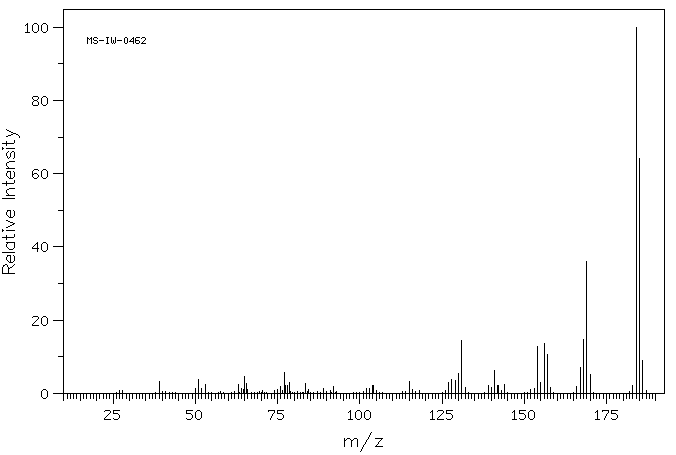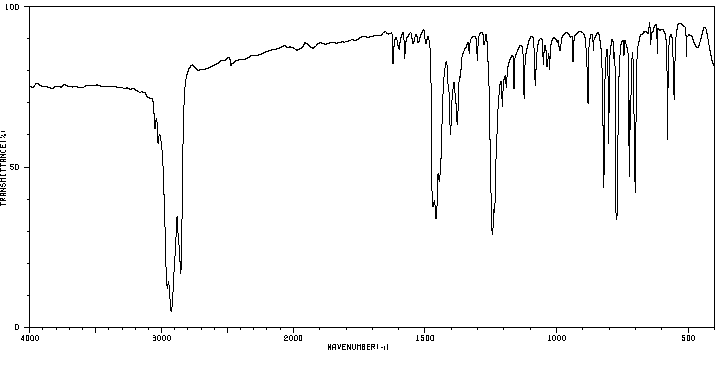4-methyl-2-phenylpyridine 1-oxide | 80635-42-3
中文名称
——
中文别名
——
英文名称
4-methyl-2-phenylpyridine 1-oxide
英文别名
4-Methyl-1-oxido-2-phenylpyridin-1-ium
CAS
80635-42-3
化学式
C12H11NO
mdl
——
分子量
185.225
InChiKey
DEUGGFSKAPAFRM-UHFFFAOYSA-N
BEILSTEIN
——
EINECS
——
-
物化性质
-
计算性质
-
ADMET
-
安全信息
-
SDS
-
制备方法与用途
-
上下游信息
-
文献信息
-
表征谱图
-
同类化合物
-
相关功能分类
-
相关结构分类
计算性质
-
辛醇/水分配系数(LogP):1.9
-
重原子数:14
-
可旋转键数:1
-
环数:2.0
-
sp3杂化的碳原子比例:0.08
-
拓扑面积:25.5
-
氢给体数:0
-
氢受体数:1
上下游信息
-
上游原料
中文名称 英文名称 CAS号 化学式 分子量 4-甲基-2-苯基吡啶 4-methyl-2-phenylpyridine 3475-21-6 C12H11N 169.226 -
下游产品
中文名称 英文名称 CAS号 化学式 分子量 —— 4-Methyl-6-phenyl-pyridine-2-carbonitrile 80635-45-6 C13H10N2 194.236
反应信息
-
作为反应物:描述:4-methyl-2-phenylpyridine 1-oxide 在 盐酸 、 氯化亚砜 、 硫酸二甲酯 作用下, 反应 14.5h, 生成 4-Methyl-6-phenyl-pyridine-2-carbonyl chloride参考文献:名称:Antiallergic agents. 2. N-(1H-Tetrazol-5-yl)-6-phenyl-2-pyridinecarboxamides摘要:A new series of N-(1H-tetrazol-5-yl)-6-phenyl-2-pyridinecarboxamides was prepared to determine the effects of substituents on the benzene and pyridine rings on antiallergic activity in the rat passive cutaneous anaphylaxis (PCA) assay after oral administration. One member of this series, N-(1H-tetrazol-5-yl)-4-methyl-6-[4-(methylamino)-phenyl]-2- pyridinecarboxamide (231), has an ED50 value of 0.8 mg/kg po and is 85 times more potent than disodium cromoglycate (DSCG) on intravenous administration. Further evaluation of 231 as a clinically useful antiallergic agent is in progress.DOI:10.1021/jm00364a026
-
作为产物:描述:2-氯-4-甲基吡啶 在 四(三苯基膦)钯 、 potassium carbonate 、 间氯过氧苯甲酸 作用下, 以 乙醇 、 氯仿 、 水 、 甲苯 为溶剂, 反应 60.0h, 生成 4-methyl-2-phenylpyridine 1-oxide参考文献:名称:Pd(II)-催化的 2-苯基吡啶 N-氧化物与碘苯在水中的单芳基化摘要:摘要:Pd(II) 催化的 C(sp2)-H 键在水中由吡啶 N-氧化物引导的活化和芳基化,以高区域选择性形成单芳基化产物,产率高达 91%。广泛的底物范围突出了催化剂的灵活性。提出了反应机理,并以COX-2抑制剂类似物的合成为例说明了该方法的应用。图形概要DOI:10.1080/00397911.2017.1285937
文献信息
-
External oxidant-free alkylation of quinoline and pyridine derivatives作者:Linhua Shen、Xianying Gao、Nannan Luan、Zhenwei Liu、Jingya Li、Dapeng Zou、Yangjie Wu、Yusheng WuDOI:10.1039/c9ob02653c日期:——A novel and efficient method for the generation of alkyl radicals and the alkylation of quinoline and pyridine derivatives under mild conditions has been developed. This strategy allows the direct alkylation of heteroaromatics in the absence of an external oxidant. A preliminary mechanistic study suggests that the present reaction probably proceeds via an intermolecular HAT process.
-
Nickel-catalyzed C H trifluoromethylation of pyridine N-oxides with Togni’s reagent作者:Xianying Gao、Yang Geng、Shuaijun Han、Apeng Liang、Jingya Li、Dapeng Zou、Yangjie Wu、Yusheng WuDOI:10.1016/j.tetlet.2018.02.077日期:2018.4The first nickel-catalyzed CH trifluoromethylation of pyridine N-oxides with Togni’s reagent has been achieved. Trifluoromethylation proceeds smoothly under mild conditions with moderate functional group compatibility. Notable advantages of this method include the using of low cost of nickel catalyst, and its simple convenient operation.
-
Palladium-catalyzed direct C–H arylation of pyridine N-oxides with potassium aryl- and heteroaryltrifluoroborates作者:Mengli Li、Xing Li、Honghong Chang、Wenchao Gao、Wenlong WeiDOI:10.1039/c5ob02409a日期:——An efficient ligand-free Pd(OAc)2-catalyzed selective arylation of pyridine N-oxides using potassium (hetero)aryltrifluoroborates as coupling partners via C–H bond activation was achieved in the presence of TBAI. This approach has a broad substrate scope and shows moderate to high yields.
-
NITROCATECHOL DERIVATIVES AS COMT INHIBITORS申请人:Learmonth David Alexander公开号:US20120196904A1公开(公告)日:2012-08-02New compounds of formula I are described. The compounds have potentially valuable pharmaceutical properties in the treatment of some central and peripheral nervous system disorders.本文描述了一种公式I的新化合物。这些化合物在治疗某些中枢和周围神经系统疾病方面具有潜在的有价值的药物特性。
-
US8907099B2申请人:——公开号:US8907099B2公开(公告)日:2014-12-09
表征谱图
-
氢谱1HNMR
-
质谱MS
-
碳谱13CNMR
-
红外IR
-
拉曼Raman
-
峰位数据
-
峰位匹配
-
表征信息
同类化合物
(S)-氨氯地平-d4
(R,S)-可替宁N-氧化物-甲基-d3
(R)-(+)-2,2'',6,6''-四甲氧基-4,4''-双(二苯基膦基)-3,3''-联吡啶(1,5-环辛二烯)铑(I)四氟硼酸盐
(R)-N'-亚硝基尼古丁
(R)-DRF053二盐酸盐
(5E)-5-[(2,5-二甲基-1-吡啶-3-基-吡咯-3-基)亚甲基]-2-亚磺酰基-1,3-噻唑烷-4-酮
(5-溴-3-吡啶基)[4-(1-吡咯烷基)-1-哌啶基]甲酮
(5-氨基-6-氰基-7-甲基[1,2]噻唑并[4,5-b]吡啶-3-甲酰胺)
(2S,2'S)-(-)-[N,N'-双(2-吡啶基甲基]-2,2'-联吡咯烷双(乙腈)铁(II)六氟锑酸盐
(2S)-2-[[[9-丙-2-基-6-[(4-吡啶-2-基苯基)甲基氨基]嘌呤-2-基]氨基]丁-1-醇
(2R,2''R)-(+)-[N,N''-双(2-吡啶基甲基)]-2,2''-联吡咯烷四盐酸盐
(1'R,2'S)-尼古丁1,1'-Di-N-氧化物
黄色素-37
麦斯明-D4
麦司明
麝香吡啶
鲁非罗尼
鲁卡他胺
高氯酸N-甲基甲基吡啶正离子
高氯酸,吡啶
高奎宁酸
马来酸溴苯那敏
马来酸氯苯那敏-D6
马来酸左氨氯地平
顺式-双(异硫氰基)(2,2'-联吡啶基-4,4'-二羧基)(4,4'-二-壬基-2'-联吡啶基)钌(II)
顺式-二氯二(4-氯吡啶)铂
顺式-二(2,2'-联吡啶)二氯铬氯化物
顺式-1-(4-甲氧基苄基)-3-羟基-5-(3-吡啶)-2-吡咯烷酮
顺-双(2,2-二吡啶)二氯化钌(II) 水合物
顺-双(2,2'-二吡啶基)二氯化钌(II)二水合物
顺-二氯二(吡啶)铂(II)
顺-二(2,2'-联吡啶)二氯化钌(II)二水合物
韦德伊斯试剂
非那吡啶
非洛地平杂质C
非洛地平
非戈替尼
非布索坦杂质66
非尼拉朵
非尼拉敏
雷索替丁
阿雷地平
阿瑞洛莫
阿扎那韦中间体
阿培利司N-6
阿伐曲波帕杂质40
间硝苯地平
间-硝苯地平
镉,二碘四(4-甲基吡啶)-
锌,二溴二[4-吡啶羧硫代酸(2-吡啶基亚甲基)酰肼]-








